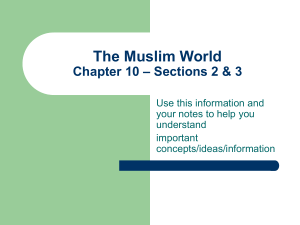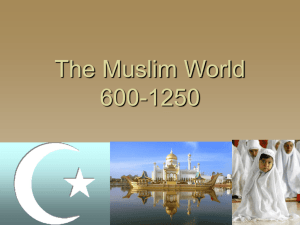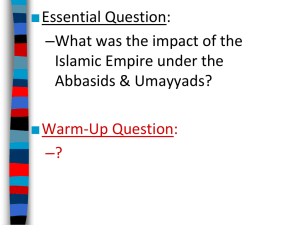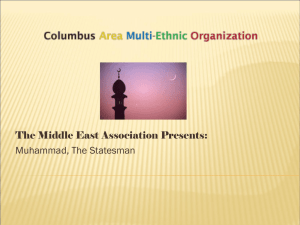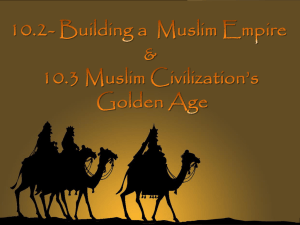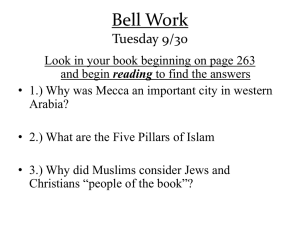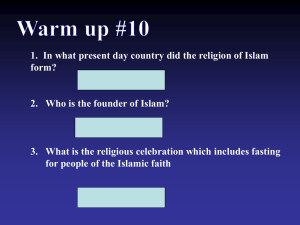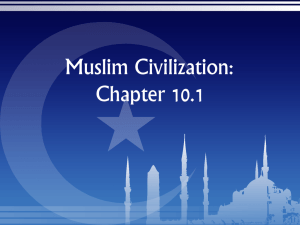Islam: A World Religion
advertisement
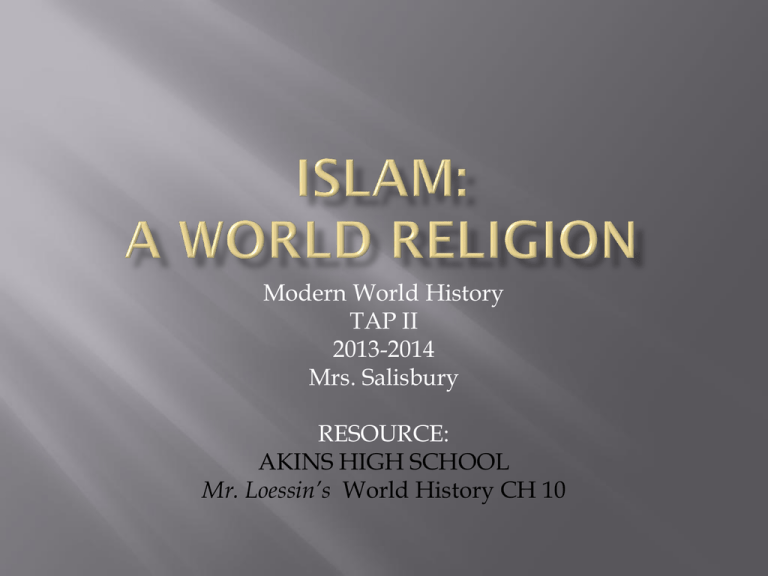
Modern World History TAP II 2013-2014 Mrs. Salisbury RESOURCE: AKINS HIGH SCHOOL Mr. Loessin’s World History CH 10 • • He believed God spoke to him through the Angel Gabriel that he was the “last of the great prophets” now had to teach others that Allah was the one and only God and all the other gods in Arabia had to be abandoned. Muhammad’s new idea of “one” God (monotheism) angered many those who, for centuries, had worshiped the many traditional Arab gods. Mecca’s economy thrived on the pilgrimages Arabs made frequent visits to shrines of the many gods. If only one God visitors would stop coming = end lucrative trade income. Muhammad’s flight from Mecca to Medina in 622. The Islamic world begins its calendear Year 1 with this event. In other words, our year 622 A.D. is their year 1 A.H. Mecca’s opposition to Muhammad only brought attention to new religion He gained a wide following in Medina. Now a religious leader, & political leader – united various Arab tribesmen. Military leader now due to: conflict between Mecca and Medina. Muhammad used Mecca as a base To do what?: unify the entire Arabian peninsula. • Monotheism – • • • Each person is responsible for his or her own actions. Allah will judge all people on a final judgment day. Mosque – place of worship for Muslims Minaret – There is only one God (Allah). prayer tower Muezzin – prayer crier, he cries out the time of prayer 5 times a day. Muslims circling around the sacred Ka`aba in Mecca, climax of the hajj pilgrimage hajj – pilgrimage to Mecca all Muslims must make in their lifetime. Sunna – Muhammad’s model for proper living. shariah – a system of laws in Islam. • • Muslims do not separate their personal life from their religious life. Carrying out the Five Pillars daily as well as other customs ensures that Muslims live their faith while serving in the community. A Muslim woman wears a hijab. Qu’ran written in Arabic all followers are required to read it, one language and that one religion created unity. The SIGNIFICANCE of Muhammad is… he single-handedly unified hundreds of nomadic tribes in Arabia who spoke different languages and worshipped hundreds of different gods. He did this with one tool: the Qu’ran ! Written in a COMMON LANGUAGE (Arabic) + providing a COMMON RELIGION (Islam) = he achieved Arabian UNITY. Shariah law required Muslims to extend religious tolerance to Christians and Jews – the “people of the book.” Muhammad had not named a successor nor instructed his followers how to choose one. Relying on ancient tribal custom Muslim community elected Abu-Bakr as the new leader and Muhammad’s first successor. Loyal friend of Muhammad, accompanied him on the Hejirah, and a man respected for his devotion to Islam. Under Abu-Bakr, the collection of Mohammad's revelations recorded in the Qur’an In 632, Abu-Bakr became the first caliph a title that means “successor” or “deputy.” 1. What did the “rightly guided” caliphs use as guides to leadership? The Qur’an and Muhammad’s actions in life. Abu-Bakr and the next three elected caliphs—Umar, Uthman, and Ali—all had known Muhammad and supported his mission. They used the Qur’an and Muhammad’s actions as guides to leadership. For this, they are known as the “rightly guided” caliphs. The region ruled by a caliph was called a caliphate. What is the meaning of the word “caliph?” successor Abu-Bakr had promised the Muslim community he would uphold what Muhammad stood for. For two years, Abu-Bakr used military force to reassert the authority of Muhammad’s successors in the Muslim community. By the time Abu-Bakr died in 634, the Muslim state controlled all of Arabia Under Umar, the second caliph, swift and highly disciplined armies conquered Syria and lower Egypt, which were part of the Byzantine Empire. The next two caliphs, Uthman and Ali, continued to expand Muslim territory both eastward and westward. By 750, from the Atlantic Ocean to the Indus River, the Muslim Empire stretched 6,000 miles—about two times the distance across the continental United States. 2. What changes did they make during their rule? They mobilized highly-disciplined armies that conquered Arabia, parts of the Byzantine Empire, and Persia. • • • • 3. Why were they successful in their quest to expand the empire and spread Islam? Muslims were willing to fight to extend and defend Islam. Armies were well-disciplined and expertly commanded. The Byzantine and Persian empires were weak at this time. People who had suffered religious persecution welcomed the more tolerant Islamic empire. Many conquered peoples chose to accept Islam. They were attracted by the appeal of the message of Islam, as well as by the economic benefit for Muslims of not having to pay a poll tax. Christians and Jews, as “people of the book,” were allowed to practice their faiths freely and even received special consideration. Christians and Jews played important roles as officials, scholars, and bureaucrats in the Muslim state. In practice, tolerance like this was extended to other groups as well. The murder of Uthman in 656 triggered a civil war, with various groups struggling for power. A family known as the Umayyad (oo•MYE•yadz) came to power. They set up a hereditary system of succession The Umayyads 4. What ended the elective system of choosing a caliph? When the Umayyads came to power after a bloody civil war, they set up a hereditary system of succession. 5. What other changes did they make during their rule? They moved the capital to Damascus. They abandoned the simple life of previous caliphs, and began surrounding themselves with wealth and ceremonies. When y at the e of the conque the Um what lo reason they ha for rel the ca Dama In the interest of peace, the majority of Muslims accepted the Umayyads’ rule. A minority did continue to resist, and around some of these groups an alternate view of the office of caliph developed. In this view, the caliph—the person most responsible for spreading Muhammad’s message—needed to be a relative of the Prophet. This group was called Shi’a, meaning the “party” of Ali. Those who did not outwardly resist the rule of the Umayyads later became known as Sunni, meaning followers of Muhammad’s example. Another group, the Sufi (SOO•fee), reacted to the luxurious life of the Umayyads by pursuing a life of poverty and devotion to a spiritual path. They tried to achieve direct personal contact with God through mystical means, such as meditation and chanting. In some ways they were similar to Christian and Buddhist monks. The Sufis played an important role in keeping Muslims focused on the Qur’an and tradition. Later, they became very active as missionaries in newly conquered lands. Another religious development was the growth of scholarship in various branches of Islamic learning and law. The study of the traditions of Muhammad, Arabic language, and the development of schools of shari’a established standards of Islamic conduct. What led to the downfall of the Umayyads? The division of Islam into Sunni, Shi’a, and Sufi branches. The Sunni and Shi’a had different ideas about leadership; and the Sufi practiced lives of extreme poverty and religious devotion. B. The 3 Different Branches or Sects Within Islam Sunni – choose their caliph by election. Approx. 80% Muslims are Sunni. Shi’a – believe the caliph must be a relative of Muhammad. Approx. 17% Muslims are Shi’a. Sufi – abandon material possessions, live simple “monastic” life Vigorous religious and political opposition to the Umayyad caliphate led to its downfall. Especially troubling to Muslims was the Umayyad obsession with material wealth. Rebel groups overthrew the Umayyads in the year 750. The most powerful of those groups, the Abbasids (AB•uh•SIHDZ), took control of the empire. . How did the Abbasids come to power? They were the most powerful of the rebel groups that overthrew the Ummayads. 8. What changes did they make during their rule? They moved the capital to Baghdad, developed a strong government bureaucracy, created an efficient tax system, and a strong trade network. The Abbasids’ strength lay in the former Persian lands – including Iraq, Iran, and central Asia. A chancery prepared letters and documents. A special department managed the business of the army. Diplomats from the empire were sent to courts in Europe (for example, Charlemagne’s court), Africa, and Asia to conduct imperial business. To support this bureaucracy, the Abbasids taxed land, imports, and exports, and non-Muslims’ wealth. 8. What major problem did the Abbasids face? They were unable to complete solid political control over such an immense empire. Set up dynasty that ruled until 750 Moved capital to Damascus Conquered lands from Atlantic to the Indus Valley Relied on local officials to govern the empire, while the Umayyads themselves lived in great luxury. Faced economic tensions between wealthy and poor Arabs Split in Islam occurs during their reign – between Sunni, Shi’a, Sufi. Overthrew the Umayyads in 750 Moved capital to Baghdad Ended Arab dominance and helped make Islam a universal religion Empire of the caliphs reached its greatest wealth and power through strong trade network. Muslim civilization enjoyed a Golden Age Difficulty controlling vast empire The Abbasid caliphate lasted from 750 to 1258. The Fatimid (FAT•uh•MIHD) Dynasty, named after Muhammad’s daughter Fatima, ruled in North Africa and spread across the Red Sea to western Arabia and Syria. Although politically divided, the Abbasid Empire and the smaller powers remained unified in other ways. Religion, language, trade, and the economy tied the lands together The two major sea-trading zones—those of the Mediterranean Sea and the Indian Ocean— linked the Muslim Empire into a world system of trade by sea. The land network connected the Silk Roads of China and India with Europe and Africa. Muslim merchants needed only a single language, Arabic, and a single currency, the Abbasid dinar, to travel from Córdoba, in Spain, to Baghdad and on to China. To encourage the flow of trade, Muslim moneychangers set up banks in cities throughout the empire. Banks offered letters of credit, called sakks, to merchants. A merchant with a sakk from a bank in Baghdad could exchange it for cash at a bank in any other major city in the empire. In Europe, the word sakk was pronounced, “check.” Thus, the practice of using checks dates back to the Muslim Empire.
